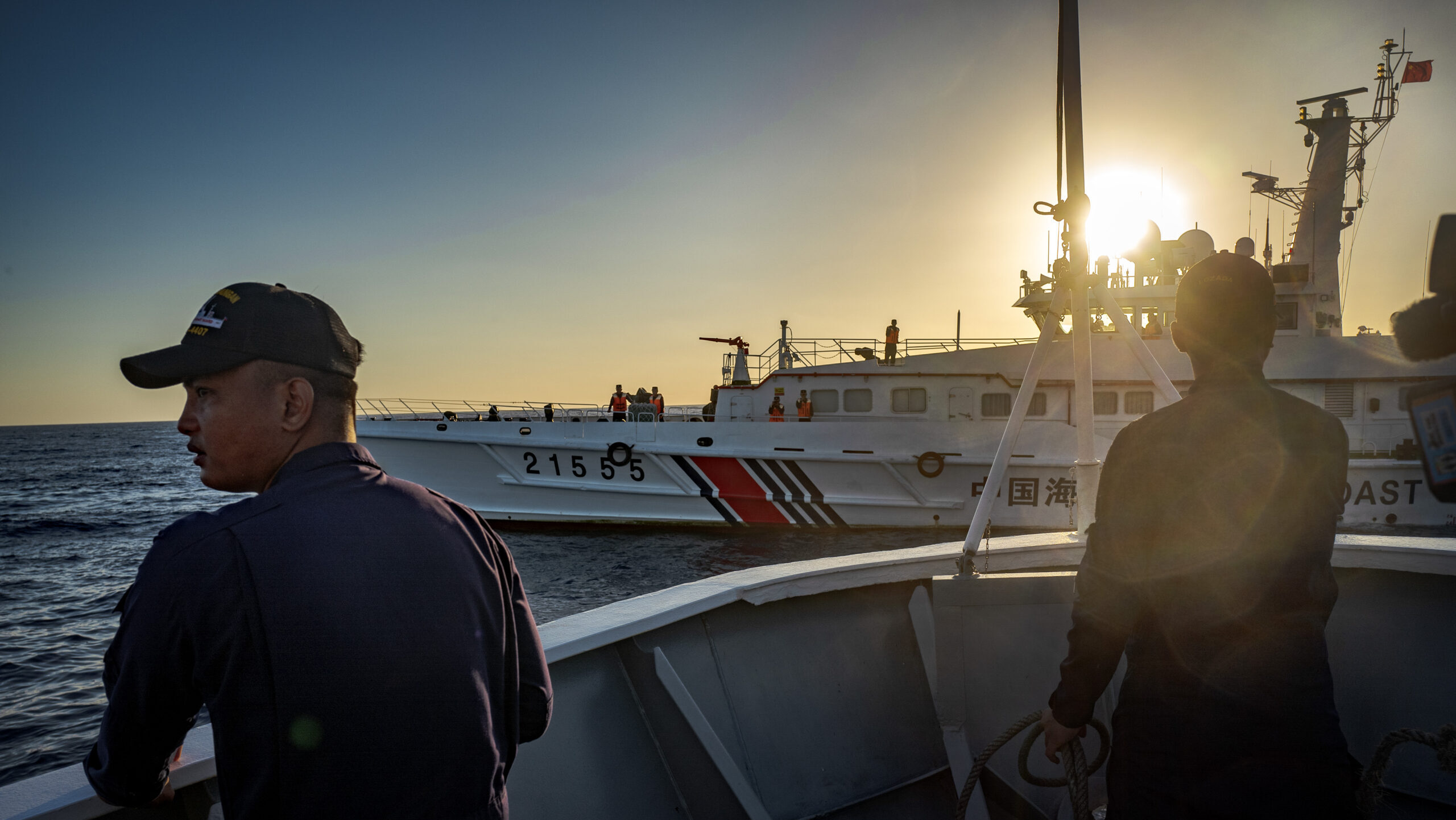Philippine Coast Guard personnel aboard BRP Sindangan look on as a Chinese Coast Guard ship sails nearby, during resupply mission to troops stationed at Second Thomas Shoal, on March 05, 2024 in the South China Sea. (Photo by Ezra Acayan/Getty Images)
SYDNEY — Recent collisions between Chinese and Philippine ships in the South China Sea reflect Beijing’s aggressive behavior in the region and is clearly meant to test Manila’s relationship with Washington, experts say.
That latest literal run-ins between Chinese and Philippine vessels came early Monday, near Sabina Shoal, a disputed bit of land in the contentious sea. Two ships were damaged; no one was injured this time.
Though two analysts told Breaking Defense it was unclear who was to blame, a senior White House official, the Philippines and another expert have laid the blame at Beijing’s doorstep.
US National Security Advisor Jake Sullivan told his Philippine counterpart that the US “condemned the People’s Republic of China’s deliberate collision” with the Philippine Coast Guard vessels, which were “operating lawfully,” according to a White House readout of the call.
The Philippine government said China was at fault, with Jonathan Malaya, assistant director-general of its National Security Council, stating the Chinese Coast Guard was wrong and was trying to deliberately misrepresent what happened.
The Chinese Coast Guard said the Philippines was responsible for causing the collisions.
A regional expert who is one of the closest observers of China’s military activities in the region said it was clear China is to blame.
“Based on existing information, notwithstanding the video put out by [the Chinese Coast Guard], it’s clear that the Chinese were responsible. Their maneuvers against PCG [Philippine Coast Guard] vessels were aggressive and in contravention of COLREGs (collision regulations),” Collin Koh, at Singapore’s Nanyang Technological University wrote, in an email.
“As it stands for now, Beijing appears to want to compel Manila to relinquish Sabina Shoal,” he said. “Manila isn’t keen to allow a repeat of the Scarborough Shoal incident in 2012, and domestic stakes are heavy to ensure that the PCG sustains this faceoff with Chinese vessels in the shoal in order to prevent Beijing’s takeover. Clearly the Philippines has so far used only PCG to do the job, and not yet tapped the navy because it sought to avoid escalation, and to prevent the use of naval forces to play into the Chinese narrative.”
Two other regional experts said that while the cause of the most recent incident itself may be difficult to judge, China was certainly trying to push the Philippines out of its own waters and test its relationship with the US.
“What the PRC side looks like they are doing is to try to wear down the Philippines such that they are not able or willing to try to demonstrate an effective presence. That will give the PRC de facto control or at least a veto over the disputed waters, which they don’t yet have,” Ian Chong-Ja, a China expert at the National University of Singapore, told Breaking Defense in an email.
China is “pushing the Philippines, in a way they are not pushing Vietnam,” which lays claim to some of the waters near the latest incident, Jennifer Parker, naval expert at the Australian National University in Canberra, wrote in an email to Breaking Defense.
China acted as it did “likely as a result of the Philippines campaign to push back against China, but also to test US resolve noting the Philippines relationship with the US,” she said. “China is known to employ dangerous and aggressive manicuring as a tactic.”
The collisions happened just nine days after a Chinese fighter dropped flares in the path of a Philippine military aircraft. The Philippines filed a formal diplomatic protest with China in response to that incident.
Such situations appear to be happening with greater frequency, ever since Philippine President Ferdinand Marcos Jr. said his country would not submit to claims by China that it legally controls a huge swath of Philippine waters, in violation of a ruling by a UN tribunal. China has simply refused to accept the ruling, although it is a signatory to the UN Convention on the Law of the Sea. The Philippines has, the president said, filed more than 100 diplomatic protests with China over aggressive and illegal actions in the region.
Last month US Defense Secretary Lloyd Austin and Secretary of State Antony Blinken visited Manila, where Austin said, “The United States, the Philippines, and our other allies and partners are operating together more closely and capably than ever, and we’re working together to ensure a free and open region.”
In his call Tuesday, the White House said Sullivan “reiterated the ironclas US commitment to the US-Philippines Mutual Defense Treaty, which extends to armed attacks on Philippine armed forces, public vessels or aircraft — including those of its Coast Guard — anywhere in the South China Sea.”











